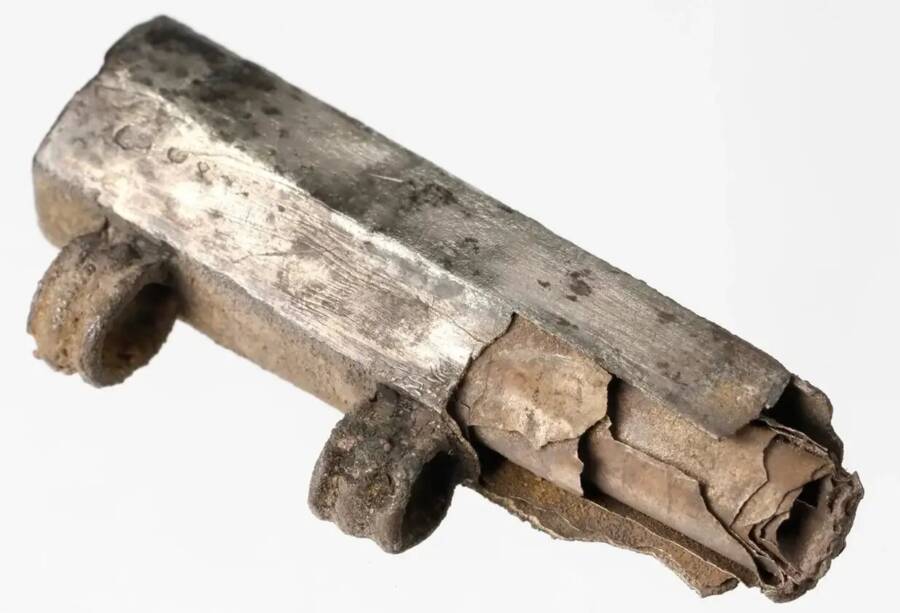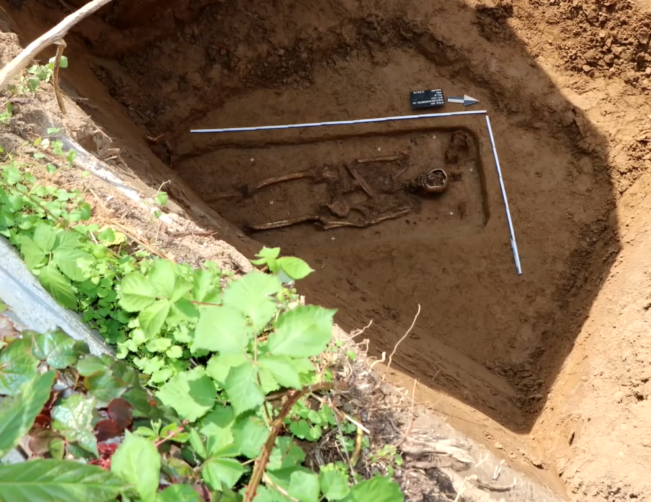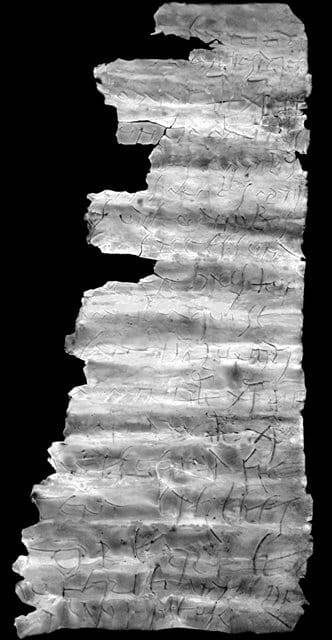A tiny scroll hidden within the inch-long amulet contained 18 lines of explicitly Christian text inscribed in Latin.

Stadt FrankfurtThis 1,800-year-old silver amulet held a tiny scroll with an early Christian inscription.
Hidden for 1,800 years, a tiny silver amulet buried in a Roman grave near Frankfurt, Germany, has now revealed the earliest evidence of Christianity north of the Alps.
In 2018, archaeologists unearthed a Roman cemetery near Frankfurt. In one grave, which dated to the third century C.E., they found the remains of a man wearing the amulet under his chin. Upon examination, researchers discovered the amulet held a fragile silver scroll. However, due to its delicate condition, the scroll couldn’t be deciphered until this year, when advanced imaging technology finally revealed that it contained 18 lines of Christian text written in Latin.
The inscription is notable for its explicitly Christian content, which invokes the name of Jesus Christ, affirms faith, and expresses protection through divine intervention. During the third century C.E., Christianity was still a forbidden religion in the Roman Empire, and Christians often practiced in secret to avoid persecution.
The existence of this amulet suggests that the man buried with it had a strong personal connection to his faith despite the risks, offering new insights into the spread of Christianity across Europe and the ordinary lives of early Christians.
Archaeologists Find An 1,800-Year-Old Silver Amulet With Shocking Contents
In 2018, researchers discovered a Roman cemetery at the ancient site of Nida outside of Frankfurt. While excavating the burial ground, archaeologists came across the grave of a man who died between 230 and 270 C.E.

Stadt Frankfurt am Main/YoutubeThe grave where the amulet was found held the remains of a man who died some 1,800 years ago.
Inside the grave were funerary objects, a clay jug, and an incense bowl, but it was the silver amulet under the man’s chin that piqued the interest of the experts. It was just over a inch long, and the man likely wore it on a cord around his neck while he was alive.
Close examination of the amulet revealed that it housed a tiny scroll made of silver foil. It was clear that there was an inscription on the scroll, but it was so thin and brittle that researchers couldn’t simply unroll it. Experts spent the next six years trying to figure out how to decipher the text inside.
In May 2024, researchers were able to scan the scroll using state-of-the-art CT technology at the Leibniz Center for Archaeology in Mainz. “The challenge in the analysis was that the silver sheet was rolled, but after around 1,800 years it was of course also bent and pressed,” said Dr. Ivan Calandra, the head of the imaging lab, in a statement from Goethe University in Frankfurt. “Using the CT, we were able to scan it in very high resolution and create a 3D model.”
For the first time, researchers could see what was inscribed on the scroll. The scans revealed 18 lines written in Latin:
“(In the name?) of Saint Titus.
Holy, holy, holy!
In the name of Jesus Christ, Son of God!
The Lord of the world
resists with [strengths?]
all attacks(?)/setbacks(?).
The God(?) grants
entry to well-being.
May this means of salvation(?) protect
the man who
surrenders himself to the will
of the Lord Jesus Christ, Son of God
since before Jesus Christ
every knee bows: those in Heaven, those on Earth
and those
under the Earth, and every tongue
confesses (Jesus Christ).”
Researchers were stunned: They’d just uncovered the earliest evidence of Christianity north of the Alps.
How The Silver Scroll Is Rewriting Early Christian History
While scholars have discovered references to Christians in Gaul in the late second century C.E., this scroll is the first reliable evidence of Christianity north of the Alpine region before the fourth century C.E. It predates all other proof by at least 50 to 100 years.
This is extraordinary in itself, but the fact that the man in the grave was wearing the amulet at all adds another layer of intrigue to the discovery.
“In the third century C.E., at a time when Christianity was still subject to reprisals but was a steadily growing cult, it was quite a risk to identify oneself as a Christian,” Dr. Marcus Gwechenberger, a Frankfurt government official, said in the statement. “For one man from Frankfurt, however, his faith was apparently so important that he took it with him to his grave. The extent to which he was able to practice and profess his faith or whether the contents of the amulet remained his secret remains to be seen.”

Leibniz Institute for Archaeology in MainzThe 18-line Christian inscription in Latin found inside the amulet.
It is also clear that whoever created the amulet took great care to make it solely Christian. The inscription, which is written in Latin and only references Christianity, is unusual for the time. Similar scrolls from the time typically contained appeals to religious figures across several faiths, not just one, and were written in Hebrew or Greek.
As the oldest evidence of Christianity north of the Alps, this scroll is rewriting what historians know about the spread of the religion throughout Europe.
“The ‘Frankfurt Inscription’ is a scientific sensation,” said Frankfurt Lord Mayor Mike Josef. “Thanks to it, the history of Christianity in Frankfurt and far beyond will have to be turned back by around 50 to 100 years. The first Christian find north of the Alps comes from our city: we can be proud of this, especially now, so close to Christmas. The people involved have done a great job.”
After reading about the silver amulet that’s rewriting the history of the spread of Christianity across Europe, learn about the Ark of the Covenant, the wooden chest believed to have once held the original Ten Commandments. Then, go inside the stories of seven early Christian martyrs.





